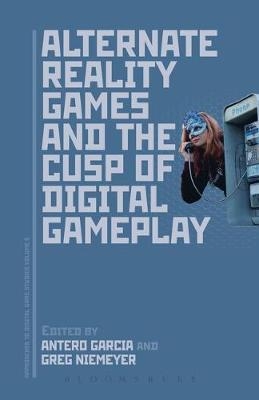
Alternate Reality Games and the Cusp of Digital Gameplay
Bloomsbury Academic USA (Verlag)
978-1-5013-1624-1 (ISBN)
With ARGs continuing to be an important and blurred space between digital and physical gameplay, this volume offers clear analysis of game design, implementation, and ramifications for game studies. Divided into three distinct sections, the contributions include first hand accounts by leading ARG creators, scholarly analysis of the meaning behind ARGs, and explorations of how ARGs are extending digital tools for analysis. By balancing the voices of designers, players, and researchers, this collection highlights how the Alternate Reality Game genre is transforming the ways we play and interact today.
Antero Garcia is an Assistant Professor in the Graduate School of Education at Stanford University, USA. His research focuses on developing literacies and civic identity through the use of gameplay and participatory media. Antero’s work appears in numerous journals including The Harvard Educational Review, English Journal, and Rethinking Schools. He is the author of the books Critical Foundations in Young Adult Literature: Challenging Genres (2013) and Teaching in the Connected Learning Classroom (2014). Greg Niemeyer is an Associate Professor and Director of the Center for New Media at University of California, Berkeley, USA. He founded the Stanford University Digital Art Center, which he directed until 2001. At UC Berkeley, he is involved in the development of the Center for New Media, focusing on the critical analysis of the impact of new media on human experiences. The Black Cloud (2008) was funded by the MacArthur Foundation to provide an alternate reality game and a social network for sensing air quality and taking actions to benefit indoor air quality. The project has evolved into a startup company under the name of Aclima Inc.
Introduction (Antero Garcia, Colorado State Univeristy, USA & Greg Niemeyer, University of California, Berkeley)
Part I: Guiding Principles of Alternate Reality Games
Chapter 1 - From Alternate to Alternative Reality: Games as Cultural Probes (Patrick Jagoda, University of Chicago, USA, Melissa Gilliam, University of Chicago, USA Peter McDonald, University of Chicago, USA and Ashlyn Sparrow University of Chicago, USA)
Chapter 2 - The Game Did Not Take Place - This Is Not a Game and blurring the lines of fiction (Alan Hook, University of Ulster, UK)
Chapter 3 - Alternate reality games for learning: A frame by frame analysis (Anthony Pellicone, Adelphi University, USA Elizabeth Bonsignore, University of Maryland, USA, Kathryn Kaczmarek, University of Maryland, USA, Kari Kraus, University of Maryland, USA, June Ahn, New York University, USA & Derek Hansen, Brigham Young University, USA)
Chapter 4 – Promotional Alternate Reality Games and the TINAG Philosophy (Stephanie Janes, Royal Holloway, University of London, UK)
Chapter 5 - The Coachella Disaster: How the puppet masters of Art of the H3ist Pulled a Victory from the Jaws of Defeat (Burcu Bakioglu, Lawrence University, USA)
Chapter 6 – Designing and Playing Peer-Produced ARGs in the Primary Classroom: Supporting Literacies through Play (Angela Colvert, University of Roehampton, UK)
Part II: New Frontiers of Alternating Reality
Chapter 7 - Games Beyond the ARG (Jeff Watson, University of Southern California, USA)
Chapter 8 - Methods: Studying Alternate Reality Games as Virtual Worlds (Calvin Johns, University of Texas at Austin, USA)
Chapter 9 - A Typology to describe Alternate Reality Games for Cultural Contexts (Diane Dufort and Federico Tajariol, University of Franche-Comté, France)
Chapter 10 - Sociability by design in an Alternate Reality Game: The case of The Trail (Elina Roinioti, University of Athens, Greece, Pandia Eleana, Panteion University, Greece, Skarpelos Yannis, Panteion University, Greece)
Chapter 11 - Ingress: a restructuring of the ARG or a new genre? An ethnography of Enlightened and Resistance factions in Brazil (Thaiane Olivera, Federal Fluminense University, Brazil)
Conclusion (Antero Garcia, Colorado State Univeristy, USA & Greg Niemeyer, University of California, Berkeley)
Index
| Erscheinungsdatum | 04.05.2017 |
|---|---|
| Reihe/Serie | Approaches to Digital Game Studies |
| Zusatzinfo | 25 bw illus |
| Verlagsort | New York |
| Sprache | englisch |
| Maße | 140 x 216 mm |
| Gewicht | 553 g |
| Themenwelt | Informatik ► Weitere Themen ► Computerspiele |
| Mathematik / Informatik ► Mathematik ► Angewandte Mathematik | |
| Mathematik / Informatik ► Mathematik ► Finanz- / Wirtschaftsmathematik | |
| Sozialwissenschaften ► Kommunikation / Medien ► Medienwissenschaft | |
| ISBN-10 | 1-5013-1624-9 / 1501316249 |
| ISBN-13 | 978-1-5013-1624-1 / 9781501316241 |
| Zustand | Neuware |
| Informationen gemäß Produktsicherheitsverordnung (GPSR) | |
| Haben Sie eine Frage zum Produkt? |
aus dem Bereich


